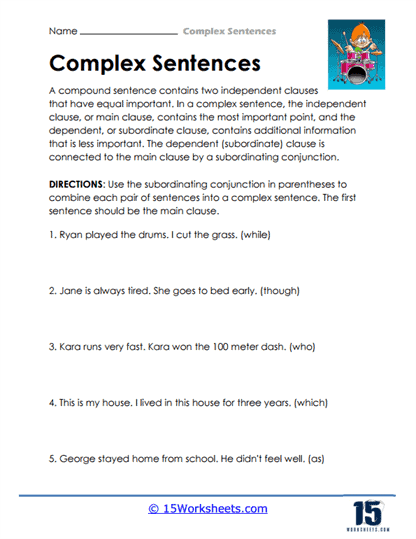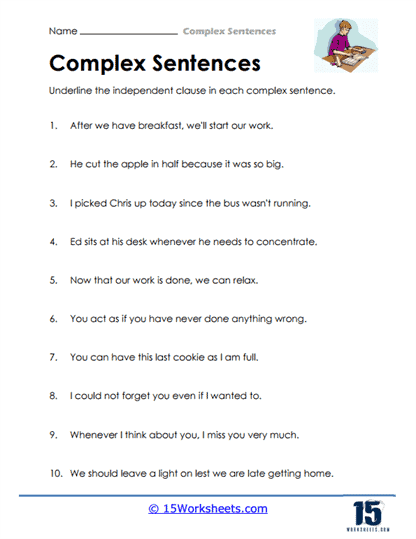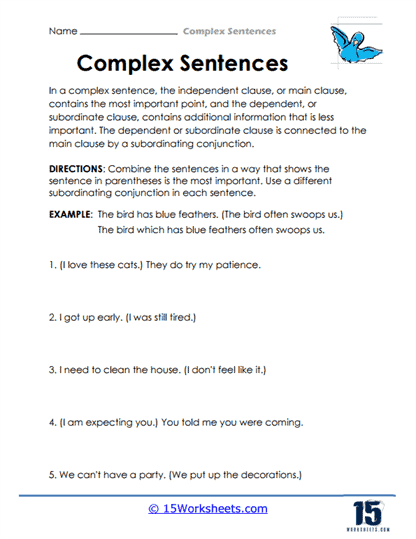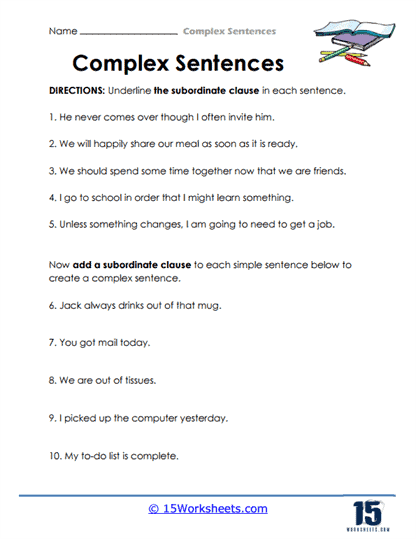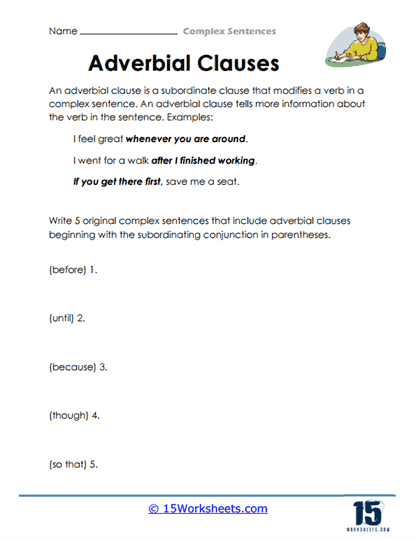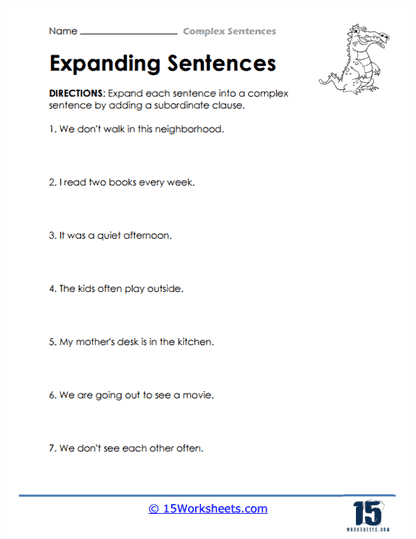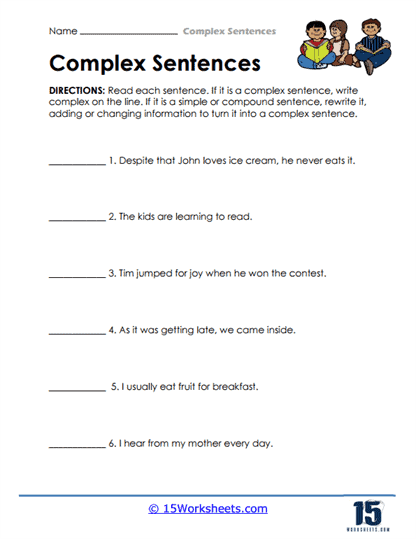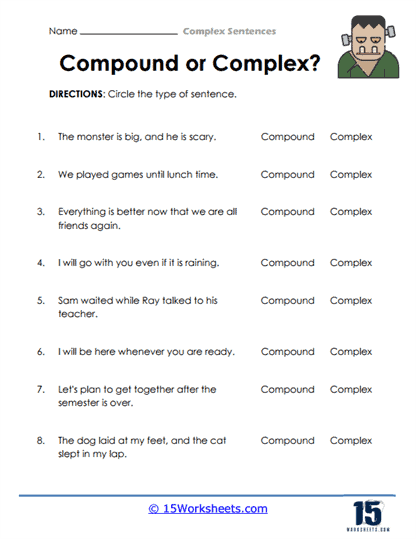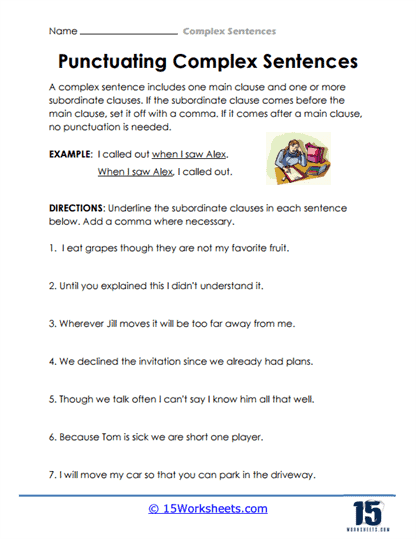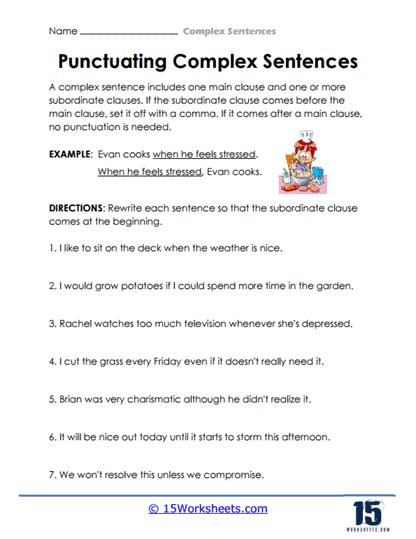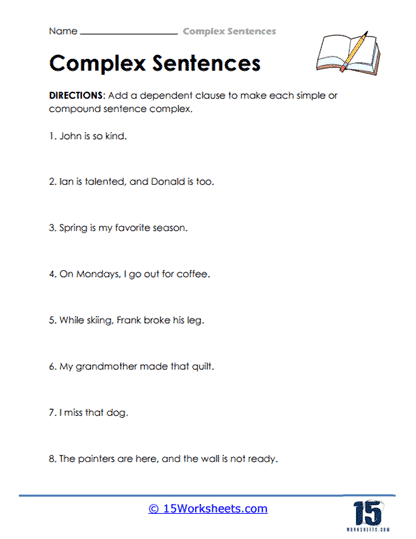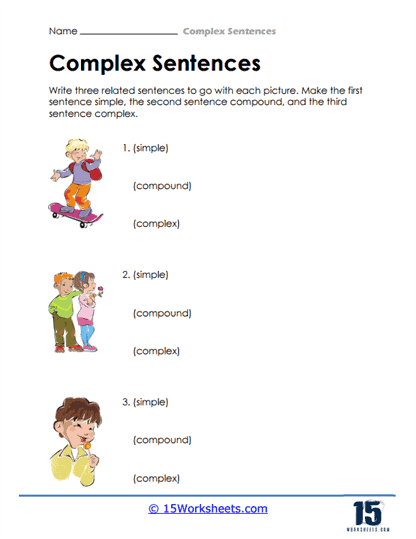Complex Sentences Worksheets
All About These 15 Worksheets
These worksheets typically contain a series of exercises or questions that require students to identify, create, or analyze simple and complex sentences.
Our adventure begins with “Combining Pairs,” where students play matchmaker to lonely clauses, uniting them into harmonious complex sentences. It’s like a reality show for sentences-will the independent clause find its dependent match? Next, “Identifying Sentence Types” challenges students to discern between simple, compound, and complex sentences. It’s a grammatical game of “Guess Who?” where every sentence has a secret identity.
In “Add A Dependent Clause,” students are the architects, building extensions onto bare-bones sentences. Think of it as home improvement for your writing. Then, “Find And Underline” turns learners into detectives, hunting down dependent clauses lurking within complex sentences. Magnifying glasses optional, but encouraged for dramatic effect.
“The Most Important” worksheet tasks students with ranking clauses by significance-a philosophical exercise that might lead to existential musings about main clauses and life’s purpose. Meanwhile, “Subordinating Conjunctions” introduces the unsung heroes of complex sentences: words like “although,” “because,” and “since.” They’re the glue holding our thoughts together, much like duct tape in a writer’s toolbox.
“Subordinate Clauses” dives deeper into the world of dependent clauses, those sentence fragments that can’t stand alone but still have so much to say. Students learn to identify and appreciate these grammatical sidekicks. In “Five Original,” creativity takes center stage as students craft their own complex sentences-five times over. It’s like sentence CrossFit: challenging, repetitive, and oddly satisfying.
This suite of worksheets is a veritable playground for sentence enthusiasts. “Sentence Expansion” encourages students to beef up their sentences with additional details-because who likes a skinny sentence? “Identify And Rewrite” is the makeover show of grammar, transforming lackluster sentences into complex beauties. “Compound Or Complex?” poses the ultimate identity crisis, forcing students to distinguish between two similar yet fundamentally different sentence types. “Adding A Comma” teaches the delicate art of punctuation placement-because a misplaced comma can lead to eating Grandma. “Rearranging And Rewriting” challenges students to shuffle sentence components like a deck of cards, seeking that perfect hand. “Make It Complex” is the workshop’s namesake, pushing students to elevate their writing. Finally, “About The Pictures” adds a visual twist, prompting students to craft complex sentences inspired by images-proving that a picture is worth a thousand clauses.
The worksheets may include various activities, such as:
Sentence Identification – Students are given a set of sentences and they have to identify whether each sentence is simple or complex. This helps them grasp the basic differences between the two sentence types.
Sentence Construction – Students are provided with a set of words or phrases and they need to use them to create simple and complex sentences. This activity allows them to practice forming sentences correctly.
Sentence Analysis – Students are given complex sentences and they have to identify the main clause and subordinate clause(s) within the sentence. This helps them understand the structure and components of complex sentences.
Sentence Transformation – Students are given a simple sentence and they have to transform it into a complex sentence by adding a subordinate clause. This activity helps students develop the ability to expand their sentences and vary their sentence structures.
Sentence Combining – Students are given two or more simple sentences and they have to combine them into a single complex sentence. This exercise encourages students to think about how ideas can be linked together to create more complex and cohesive writing.
What are Complex Sentences?
Complex sentences are sentences that contain an independent clause (a complete sentence) and at least one dependent clause (an incomplete sentence). The dependent clause relies on the independent clause for meaning and cannot stand alone as a complete sentence. Complex sentences are used to express relationships between ideas, such as cause and effect, condition, contrast, concession, and time.
Here are five examples of complex sentences:
“Although it was raining, she went for a walk.”
Independent clause: “She went for a walk.”
Dependent clause: “Although it was raining.”
This sentence shows a contrast between the action of going for a walk and the condition of rain.
“Because I studied hard, I passed the exam.”
Independent clause: “I passed the exam.”
Dependent clause: “Because I studied hard.”
This sentence shows a cause and effect relationship between studying hard and passing the exam.
“I will go to the party if I finish my work.”
Independent clause: “I will go to the party.”
Dependent clause: “if I finish my work.”
This sentence expresses a condition. The speaker will go to the party if they finish their work.
“She couldn’t watch the movie since she didn’t have a ticket.”
Independent clause: “She couldn’t watch the movie.”
Dependent clause: “since she didn’t have a ticket.”
This sentence indicates a cause and effect relationship. The reason for not being able to watch the movie is the lack of a ticket.
“After I eat dinner, I will go for a run.”
Independent clause: “I will go for a run.”
Dependent clause: “After I eat dinner.”
This sentence expresses a time relationship. The speaker plans to go for a run after eating dinner.
How Do You Identify a Complex Sentence?
To identify a complex sentence, you need to look for certain structural elements within the sentence. A complex sentence consists of an independent clause and at least one dependent clause. Here’s how you can identify a complex sentence:
Look for an Independent Clause – An independent clause is a group of words that can stand alone as a complete sentence because it expresses a complete thought. It contains a subject and a predicate. Identify the main idea or complete thought in the sentence.
Example: “I went to the store.”
In this sentence, “I went to the store” is an independent clause.
Look for a Dependent Clause – A dependent clause, also known as a subordinate clause, cannot stand alone as a complete sentence because it does not express a complete thought. It depends on the independent clause for meaning and usually begins with a subordinating conjunction or a relative pronoun.
Example: “because I needed some groceries.”
In this sentence, “because I needed some groceries” is a dependent clause.
Identify the Relationship – Determine how the dependent clause is related to the independent clause. Dependent clauses can express various relationships such as cause and effect, condition, contrast, concession, and time.
Example: “I went to the store because I needed some groceries.”
In this sentence, the independent clause is “I went to the store,” and the dependent clause is “because I needed some groceries.” The dependent clause provides the reason or cause for the action expressed in the independent clause.

